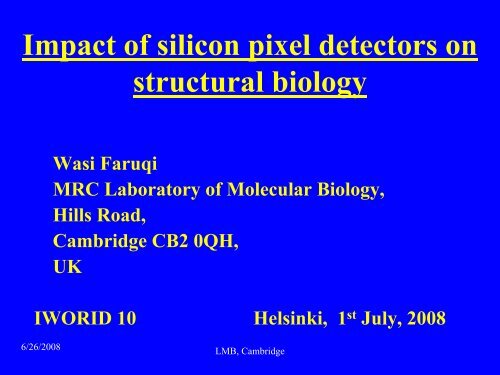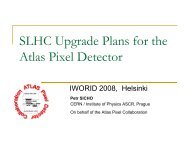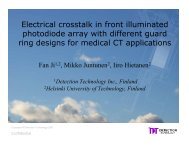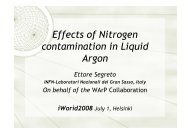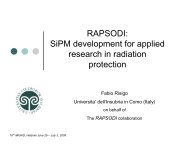LMB Cambridge - Helsinki Institute of Physics
LMB Cambridge - Helsinki Institute of Physics
LMB Cambridge - Helsinki Institute of Physics
You also want an ePaper? Increase the reach of your titles
YUMPU automatically turns print PDFs into web optimized ePapers that Google loves.
Impact <strong>of</strong> silicon pixel detectors on<br />
structural biology<br />
Wasi Faruqi<br />
MRC Laboratory <strong>of</strong> Molecular Biology,<br />
Hills Road,<br />
<strong>Cambridge</strong> CB2 0QH,<br />
UK<br />
IWORID 10 <strong>Helsinki</strong>, 1 st July, 2008<br />
6/26/2008<br />
<strong>LMB</strong>, <strong>Cambridge</strong>
Kings College Chapel, <strong>Cambridge</strong><br />
6/26/2008<br />
<strong>LMB</strong>, <strong>Cambridge</strong>
MRC Laboratory <strong>of</strong> Molecular Biology,<br />
<strong>Cambridge</strong><br />
6/26/2008<br />
<strong>LMB</strong>, <strong>Cambridge</strong>
Direct Detection in Silicon Pixel<br />
• Hybrid Pixel Detectors<br />
Medipix2<br />
Detectors<br />
http://medipix.web.cern.ch/MEDIPIX/<br />
• CMOS Detectors<br />
Monolithic Active Pixel Sensors (MAPS) designed at the<br />
STFC Rutherford Lab.<br />
Pixellated silicon, readout built into each pixel.<br />
http://mi3.shef.ac.uk/<br />
6/26/2008<br />
<strong>LMB</strong>, <strong>Cambridge</strong>
Acknowledgements<br />
<strong>LMB</strong> <strong>Cambridge</strong><br />
•Richard Henderson<br />
•Greg McMullan<br />
•Shaoxia Chen<br />
CERN (Medipix2)<br />
•Lukas Tlustos,<br />
•Xavi Llopart,<br />
•M.Campbell<br />
•RAL-STFC (MAPS)<br />
•R.Turchetta<br />
•M. Prydderch,<br />
•MI3 Collaboration (RCUK)<br />
6/26/2008<br />
<strong>LMB</strong>, <strong>Cambridge</strong>
Main techniques used in structure<br />
determination<br />
X-ray (Protein) Crystallography<br />
Electron Cryo-Microscopy<br />
Nuclear Magnetic Resonance<br />
(along with other supporting technologies)<br />
6/26/2008<br />
<strong>LMB</strong>, <strong>Cambridge</strong>
Main scientific aims<br />
•Structural analysis <strong>of</strong> proteins and<br />
macromolecular complexes to atomic or near<br />
atomic resolution<br />
•Electron Cryo-Microscopy frequently used<br />
as a complementary technique to X-ray<br />
Crystallography<br />
•Example: Hepatitis B virus solved by both<br />
techniques – Example in later slide<br />
6/26/2008<br />
<strong>LMB</strong>, <strong>Cambridge</strong>
Electron Detectors & X-ray Detectors<br />
Electron Detection: What are the main differences<br />
between X-ray Detectors and Electron Detectors?<br />
Electrons 100 – 300 keV<br />
X-rays 10 – 20 keV<br />
Electrons very easily scattered and stopped by matter,<br />
So, need to:<br />
(a) install detector in a vacuum chamber, and<br />
(b) entrance window not possible on the detector<br />
Cannot use gas detectors<br />
6/26/2008<br />
<strong>LMB</strong>, <strong>Cambridge</strong>
Schematic <strong>of</strong> Microscope<br />
<strong>LMB</strong>-<strong>Cambridge</strong><br />
6/26/2008<br />
<strong>LMB</strong>, <strong>Cambridge</strong>
Scientific Background to Electron Cryo-Microscopy<br />
Three Main types <strong>of</strong> Analysis (and the resolution attained<br />
in the analysed structures):<br />
1. Single Particle (molecule) Analysis 3.8 -10 Å<br />
2. Electron Crystallography <strong>of</strong> ordered specimen, i.e. 2-D<br />
crystals ~3Å … near-atomic resolution<br />
3. Electron Tomography 20-100 Å … cell biology<br />
Electron energy preferred: 300 keV (less lens<br />
aberrations, less multiple scattering in sample, less<br />
absorption)<br />
6/26/2008<br />
<strong>LMB</strong>, <strong>Cambridge</strong>
Electron Cryo-Microscopy<br />
•Image molecules in native aqueous<br />
environment in vitreous ice (prevent de-hydration)<br />
•Trap important conformations in intermediate states <strong>of</strong> a<br />
kinetic cycle by rapid freezing : equivalent to time-resolved<br />
measurements<br />
•Images have low contrast : need sophisticated s<strong>of</strong>tware and<br />
lots <strong>of</strong> averaging<br />
•Radiation damage to specimen a severe limitation – hence<br />
need very good detectors!<br />
6/26/2008<br />
<strong>LMB</strong>, <strong>Cambridge</strong>
Single Particle Analysis<br />
No crystals required .. Makes it possible, e.g. to analyse<br />
structure <strong>of</strong> membrane proteins, which are very difficult to<br />
crystalise,<br />
Can be applied to large macromolecular complexes<br />
• Powerful technique when used in conjunction with atomic<br />
structures obtained with x-ray crystallography<br />
•Applications: Virus particles, ribosomes, etc<br />
•‘Best’ Resolution with this technique :Rotavirus capsid 3.8 Ǻ<br />
•6.5 Million copies <strong>of</strong> the capsid protein used for the map<br />
•From 8400 virus particles (excellent symmetry)<br />
6/26/2008<br />
<strong>LMB</strong>, <strong>Cambridge</strong>
Rotavirus Epidemiology<br />
Deaths due<br />
to rotavirus<br />
(diarrhea)<br />
6/26/2008<br />
Causes ~600,000 deaths annually<br />
Infection occurs from feces. Only 10 to 100 infectious particles suffice.<br />
<strong>LMB</strong>, <strong>Cambridge</strong>
Symmetry:<br />
60 x 13<br />
=780 VP6 molecules<br />
6/26/2008<br />
<strong>LMB</strong>, <strong>Cambridge</strong><br />
Zhang et al. (2008)
Side Chains<br />
3.8 Å<br />
X-ray crystallography (2F o<br />
–F c<br />
)<br />
Cryo-EM<br />
6/26/2008<br />
Settembre et al.<br />
<strong>LMB</strong>, <strong>Cambridge</strong><br />
Xing Zhang et al. (2008)
Electron Crystallography<br />
• Averaging done in crystal… many identical scattering<br />
particles<br />
• Main application: membrane proteins (but not<br />
exclusively)<br />
• Near-atomic resolution (~2.5 Å) achieved.<br />
6/26/2008<br />
<strong>LMB</strong>, <strong>Cambridge</strong>
Bacteriorhodopsin<br />
•Membrane protein family<br />
•Light driven proton pump; photocycle<br />
•Structural changes at atomic resolution studied<br />
by trapping intermediates in reaction cycle<br />
•Diffraction data collected with <strong>LMB</strong> CCD<br />
camera<br />
6/26/2008<br />
<strong>LMB</strong>, <strong>Cambridge</strong>
Electron Diffraction Studies on Bacteriorhodopsin<br />
(with R.Henderson and S. Subramaniam)<br />
6/26/2008<br />
<strong>LMB</strong>, <strong>Cambridge</strong><br />
A 7-second diffraction pattern from bacteriorhodopsin with spots visible to 2Å -1
BR Model<br />
6/26/2008<br />
<strong>LMB</strong>, <strong>Cambridge</strong> Henderson, et al JMB, 213, 899-929 (1990)
BR<br />
6/26/2008<br />
<strong>LMB</strong>, <strong>Cambridge</strong><br />
Courtesy R.Henderson
Electron Tomography<br />
1. View specimen from large number <strong>of</strong> angles,<br />
but limits due to radiation damage<br />
2. Combine views into 3-D reconstruction<br />
3. Image needs re-focusing and re-aligning after<br />
each step due to imperfections in stage construction<br />
4. Automation and electronic detectors essential!<br />
6/26/2008<br />
<strong>LMB</strong>, <strong>Cambridge</strong>
Reconstruction<br />
Tomography - Reconstruction <strong>of</strong> a 3D Model<br />
Based on a Series <strong>of</strong> Projections<br />
Projections<br />
Reconstruction<br />
6/26/2008<br />
<strong>LMB</strong>, <strong>Cambridge</strong><br />
A. Koster et al. 1997
Investigation into Mitotic Proteins using<br />
Electron Tomography<br />
John Kilmartin and Sam Li (<strong>LMB</strong>)<br />
Identify proteins common to yeast and<br />
mammalian cells using mass spectrometry.<br />
Explore function with biochemical techniques and<br />
study structure with electron tomography.<br />
6/26/2008<br />
<strong>LMB</strong>, <strong>Cambridge</strong>
6/26/2008<br />
<strong>LMB</strong>, <strong>Cambridge</strong>
Recent structures obtained using<br />
Cryo-EM on next slide<br />
a. 70S E.coli ribosome complexed with mRNA and fMettRNA<br />
(11.5 Ǻ)<br />
b. Hepatitis B virus (7.4 Ǻ)<br />
c. Actin filaments decorated with myosin heads (30-35<br />
Ǻ)<br />
d. 2D crystal Light Harvesting Complex II (3.4 Ǻ)<br />
Baker & Henderson‘Electron cryomicroscopy’<br />
International Tables for Crystallography, 451-479,(2002)<br />
6/26/2008<br />
<strong>LMB</strong>, <strong>Cambridge</strong>
Molecular structures obtained by Electron Cryo-Microscopy Magnification<br />
Micrographs:170K, Models: 1.2 Million<br />
Montage<br />
70S Ribosome<br />
6/26/2008<br />
Hepatitis B Virus Actin-Myosin (Muscle) Light Harvesting Comple<br />
<strong>LMB</strong>, <strong>Cambridge</strong>
Hepatitis B Structure<br />
Cryo-EM X-ray Crystallography<br />
Andrew Leslie <strong>LMB</strong><br />
6/26/2008<br />
<strong>LMB</strong>, <strong>Cambridge</strong>
Scientific Background to Electron Cryo-Microscopy<br />
Three Main types <strong>of</strong> Analysis (and the resolution attained<br />
in the analysed structures):<br />
1. Single Particle (molecule) Analysis 4 -10 Å<br />
2. Electron Crystallography <strong>of</strong> ordered specimen, i.e. 2-D<br />
crystals ~3Å … near-atomic resolution<br />
3. Electron Tomography 20-100 Å … cell biology<br />
Electron energy preferred: 300 keV (less lens aberrations,<br />
less multiple scattering in sample, less absorption)<br />
6/26/2008<br />
<strong>LMB</strong>, <strong>Cambridge</strong>
High Resolution Imaging Detector<br />
Requirements for Cryo-EM<br />
1. Electronic detector with computer control.. eliminate film!<br />
2. Number <strong>of</strong> independent pixels : 4000 by 4000<br />
3. Pixel Size 10 – 50 µm (has to fit in commercial microscopes)<br />
4. High sensitivity with no noise – ability to add multiple frames<br />
5. Radiation damage; should be able to withstand<br />
at least 1 MRad this would be ~ a one year dose for cryo-EM<br />
6. Readout time preferably short<br />
6/26/2008<br />
<strong>LMB</strong>, <strong>Cambridge</strong>
Medipx2(Quad) in 300 kV Microscope<br />
Mounting<br />
6/26/2008<br />
<strong>LMB</strong>, <strong>Cambridge</strong>
300 kV EM with detector installed<br />
6/26/2008<br />
<strong>LMB</strong>, <strong>Cambridge</strong><br />
Medipix Quad
Detectors: Quality Factors<br />
Sensitivity: Detective Quantum Efficiency (DQE),<br />
(S/N) 2 output /(S/N)2 input (=1 for perfect detector)<br />
DQE(0) zero spatial frequency<br />
DQE(spatial frequency)<br />
Resolution: Modulation Transfer Function (MTF)<br />
Framing Speeds… inverse <strong>of</strong> readout time<br />
Radiation Hardness … useful lifetime<br />
Dynamic Range … ability to record very weak and very<br />
strong parts <strong>of</strong> an image simultaneously (diffraction only)<br />
Defects …… Faults in fabrication, etc<br />
6/26/2008<br />
<strong>LMB</strong>, <strong>Cambridge</strong>
Monte Carlo simulation <strong>of</strong> electron trajectories in silicon.<br />
Detector thickness = 300 microns, pixel=55 microns<br />
Extension <strong>of</strong> simulations to include energy deposition<br />
6/26/2008<br />
<strong>LMB</strong>, <strong>Cambridge</strong><br />
McMullan, et al Ultramicroscopy,<br />
107,(2007), 401-413
MTF at Nyquist Frequency<br />
6/26/2008<br />
<strong>LMB</strong>, <strong>Cambridge</strong><br />
McMullan, et al<br />
Ultramicroscopy, 107, (2007),<br />
401-413
Single Electron Clusters; 240 incident electrons at 120 keV<br />
250<br />
Counts/electron vs Ext Vthl<br />
High Threshold<br />
Low Threshold<br />
200<br />
No counts<br />
1 count<br />
Counts/electron<br />
150<br />
100<br />
2 counts<br />
50<br />
0<br />
1190 1240 1290 1340 1390 1440 1490<br />
Ext Vthl (1190 __ 120 keV)<br />
3<br />
4<br />
counts<br />
6/26/2008<br />
<strong>LMB</strong>, <strong>Cambridge</strong>
Increased probability <strong>of</strong> several pixels counting an electron at<br />
lower thresholds. Seed pixel in centre <strong>of</strong> array. E=120 keV<br />
(a) (b) (c) (d) (e)<br />
(f) (g) (h) (i) (j)<br />
6/26/2008<br />
(k) (l) (m) (n) (o)<br />
<strong>LMB</strong>, <strong>Cambridge</strong>
DQE(0) and DQE(Nyquist)<br />
DQE<br />
6/26/2008<br />
<strong>LMB</strong>, <strong>Cambridge</strong><br />
Threshold(keV)
Some examples <strong>of</strong> Single Particle<br />
Imaging using the Medipix2_Quad<br />
Detector<br />
All images recorded at 120 keV<br />
McMullan & Faruqi<br />
Nucl. Instr. and Meth. A 591 (2008) 129–133<br />
6/26/2008<br />
<strong>LMB</strong>, <strong>Cambridge</strong>
Rotavirus with 1.6(left) and 160(right) electrons/pixel<br />
0.04 electron/Å 2 (at specimen) 4 electrons/Å 2<br />
Rotavirus imaged with Medipix2 Quad<br />
6/26/2008<br />
<strong>LMB</strong>, <strong>Cambridge</strong>
Single Lambda Phage on MPX2 Quad<br />
6/26/2008<br />
<strong>LMB</strong>, <strong>Cambridge</strong>
TMV: Results <strong>of</strong> image alignment<br />
Negatively stained TMV<br />
protein stacked disks:<br />
(a) first image in a series <strong>of</strong><br />
65,<br />
(b) simple sum <strong>of</strong> the 65<br />
images (blurred),<br />
(c) aligned sum <strong>of</strong> the<br />
images (sharp),<br />
(d) sample movement in Å.<br />
The scale bar in (b)<br />
indicates 500 Å<br />
6/26/2008<br />
<strong>LMB</strong>, <strong>Cambridge</strong>
Tobacco Mosaic Virus (from 65 images)<br />
Magn. =180K<br />
6/26/2008<br />
<strong>LMB</strong>, <strong>Cambridge</strong>
MAPS CMOS Detector<br />
- charged particles<br />
• no bias voltages<br />
• charge diffusion<br />
• 100% fill factor<br />
Epilayer<br />
Substrate<br />
6/26/2008<br />
Turchetta et al<br />
NIM A458 (2001) 677-689<br />
<strong>LMB</strong>, <strong>Cambridge</strong>
Monolithic Active Pixel Sensor (MAPS)<br />
General Background<br />
Monolithic Active Pixel Sensor (MAPS ) –designed at<br />
RAL*<br />
Size: 525 by 525, 25 μm square pixels<br />
Non-Radhard, standard 0.5 μm CMOS technology<br />
Each pixel contains four diodes<br />
Electrons drift to one <strong>of</strong> the four diodes in pixel<br />
Charge summed from all diodes and converted to a voltage<br />
One ADC per column; all pixels in a row read out in<br />
parallel<br />
*Prydderch, et al Nucl.Instr. & Meth. A512,(2003),358<br />
6/26/2008<br />
<strong>LMB</strong>, <strong>Cambridge</strong>
Monte Carlo simulation <strong>of</strong> electron trajectories in silicon.<br />
Detector thickness = 300 microns, pixel=55 microns<br />
Extension <strong>of</strong> simulations to include energy deposition<br />
6/26/2008<br />
<strong>LMB</strong>, <strong>Cambridge</strong><br />
McMullan, et al Ultramicroscopy,<br />
107,(2007), 401-413
MAPS in 300 keV Mounting<br />
6/26/2008<br />
<strong>LMB</strong>, <strong>Cambridge</strong>
MI-3 Consortium Members<br />
Pr<strong>of</strong>essor NM Allinson, University <strong>of</strong> Sheffield<br />
Pr<strong>of</strong>essor PP Allport, University <strong>of</strong> Liverpool<br />
Dr RL Bates, University <strong>of</strong> Glasgow<br />
Pr<strong>of</strong>essor AR Cossins, University <strong>of</strong> Liverpool<br />
Pr<strong>of</strong>essor MM El Gomati, University <strong>of</strong> York<br />
Dr AR Faruqi, MRC Laboratory <strong>of</strong> Molecular Biology<br />
Dr MJ French, CCLRC<br />
Pr<strong>of</strong>essor A Holland, Open University<br />
Pr<strong>of</strong>essor RJ Ott, <strong>Institute</strong> <strong>of</strong> Cancer Research<br />
Dr V O'Shea, University <strong>of</strong> Glasgow<br />
Pr<strong>of</strong>essor RD Speller, University College London<br />
Dr R Turchetta, CCLRC<br />
Dr K Wells, University <strong>of</strong> Surrey<br />
6/26/2008<br />
<strong>LMB</strong>, <strong>Cambridge</strong>
Imaging <strong>of</strong> 100 mesh grid in MAPS<br />
6/26/2008<br />
<strong>LMB</strong>, <strong>Cambridge</strong>
ADC Response for Single Electrons<br />
at 40 keV and 120 keV<br />
6/26/2008<br />
<strong>LMB</strong>, <strong>Cambridge</strong>
Sensitivity:<br />
Noise:<br />
MAPS Summary at 120 keV<br />
~50 ADC Units/electron<br />
~2 ADC Units<br />
Signal/Noise: 20-25<br />
Radiation Hardness:<br />
Active area<br />
10-15 kRad . Needs improvement!<br />
525 x 525 pixels need larger areas<br />
Faruqi, Henderson, Turchetta et al Nucl. Instr.& Meth 546,<br />
170-175, (2005)<br />
6/26/2008<br />
<strong>LMB</strong>, <strong>Cambridge</strong>
Radhard<br />
Technology<br />
512 x 512, 25 µm<br />
Radiation Damage to STAR250<br />
(FillFactory/Cypress Corp.) at 300 keV<br />
C<br />
Radiation Dose:<br />
A: 200kRad<br />
(annealed for 4<br />
weeks)<br />
B: 200 kRad<br />
C: 1000 kRad<br />
Contrast values<br />
labelled in bottom<br />
left image<br />
B<br />
B<br />
C<br />
A<br />
A<br />
6/26/2008<br />
<strong>LMB</strong>, <strong>Cambridge</strong>
Startracker & Film response to electrons 10 - 300 keV<br />
50<br />
Response - Film values normalised<br />
40<br />
30<br />
20<br />
10<br />
0<br />
0 50 100 150 200 250 300<br />
Electron energy (keV)<br />
Startracker<br />
Film<br />
6/26/2008<br />
<strong>LMB</strong>, <strong>Cambridge</strong>
Large Area Sensor : Specifications<br />
Pixel Size 40µm<br />
Array Size 1.4K by 1.4K<br />
Array Dimensions 5.6cm x 5.6cm<br />
Epi Thickness 15µm<br />
Frame Rate<br />
10 f/s max<br />
Noise floor<br />
28e<br />
Radiation tolerance ~
Large Area Sensor Wafer<br />
Courtesy <strong>of</strong><br />
Andy Clark &<br />
Renato Turchetta<br />
MI3<br />
Collaboration<br />
6/26/2008<br />
<strong>LMB</strong>, <strong>Cambridge</strong>
Large Area Sensor - Mounted<br />
Courtesy <strong>of</strong><br />
Andy Clark &<br />
Renato Turchetta<br />
MI3<br />
Collaboration<br />
6/26/2008<br />
<strong>LMB</strong>, <strong>Cambridge</strong>
6/26/2008<br />
Detectors for Protein Crystallography : Main<br />
Requirements<br />
High Efficiency, low noise (high DQE)<br />
Large active area; can get better S/N by increasing distance<br />
Excellent spatial resolution; need to resolve ~500 orders (3K x3K)<br />
Very large dynamic range (strong & weak spots)<br />
High rate capability (no dead time, shutterless operation)<br />
No spatial distortions or non-uniformity <strong>of</strong> response; any corrections should<br />
be stable over long periods<br />
Ability to operate at a wide range <strong>of</strong> wavelengths for MAD, 0.6Ǻ –2.5Ǻ<br />
Low cost, reliable (low maintenance)<br />
Continuous readout to eliminate beam shutter (closed during readout)<br />
PILATUS 1M and 6M (PSI, Villigen) - talks during conference<br />
Medipix3: Does it <strong>of</strong>fer special advantages for Crystallography?<br />
<strong>LMB</strong>, <strong>Cambridge</strong>
Medipix3<br />
Silicon sensor, 300 or 500 µm for very high efficiency<br />
1 or 2 counters per pixel – continuous R/W with no dead time<br />
Pixel Size : 55 µm square, very well suited for microcrystallography.<br />
Can be re-arranged to be 110 µm for medical work<br />
with higher energy x-rays<br />
Pixel level intelligence – expect improved resolution (by reducing<br />
effects <strong>of</strong> charge sharing between pixels)<br />
Counting rates ~ 10 6 counts/second/pixel<br />
Chips to be 4-side buttable (in future) for extended tiling<br />
For more details, see Michael Campbell during IWORID10 or visit:<br />
http://medipix.web.cern.ch/MEDIPIX/
Medipix3 – charge summing concept<br />
The winner takes<br />
all<br />
• The incoming<br />
quantum is assigned as<br />
a single hit<br />
• Charge processed is<br />
summed in every 4<br />
pixel cluster on an<br />
event-by-event basis<br />
55μ<br />
Medipix<br />
Collaboration<br />
6/26/2008<br />
<strong>LMB</strong>, <strong>Cambridge</strong>
55μ<br />
4<br />
5<br />
6 7<br />
DIGITAL CIRCUITRY<br />
4. Control logic<br />
(124)<br />
5. 2x15bit counters<br />
/ shift registers<br />
(480)<br />
6. Configuration<br />
latches (152)<br />
7. Arbitration<br />
circuits (100)<br />
Total digital 856<br />
2<br />
1 3<br />
17 October 2006 Michael Campbell<br />
55μ<br />
ANALOG CIRCUITRY<br />
1. Preamplifier (24)<br />
2. Shaper (134)<br />
3. Discriminators<br />
and Threshold<br />
Adjustment<br />
Circuits (72)<br />
Total analog 230
The Medipix3 Consortium<br />
• University <strong>of</strong> Canterbury, Christchurch, New Zealand<br />
• CEA, Paris, France<br />
• CERN, Geneva, Switzerland,<br />
• DESY-Hamburg, Germany<br />
• Albert-Ludwigs<br />
Ludwigs-Universität Freiburg, , Germany,<br />
• University <strong>of</strong> Glasgow, Scotland, UK<br />
• Leiden Univ., The Netherlands<br />
• NIKHEF, Amsterdam, The Netherlands<br />
• Laboratory <strong>of</strong> Molecular Biology, <strong>Cambridge</strong>, England, UK<br />
• Mid Sweden University, Sundsvall, , Sweden<br />
• Czech Technical University, Prague, Czech Republic<br />
• ESRF, Grenoble, , France<br />
• Universität Erlangen-Nurnberg<br />
Nurnberg, Erlangen, , Germany<br />
• University <strong>of</strong> California, Berkeley, USA<br />
• VTT, Information Technology, Espoo, , Finland<br />
• ISS, Forschungszentrum Karlsruhe, Germany<br />
• Diamond Light Source, Oxfordshire, UK<br />
6/26/2008<br />
<strong>LMB</strong>, <strong>Cambridge</strong>
Microcrystallography – A new application?<br />
Useful technique for very small crystals, ~20 µm 3<br />
(large crystals more difficult to grow in many cases)<br />
ESRF Micr<strong>of</strong>ocus Beam ID13, Focused beam size ~1 µm<br />
Energy=13 keV,<br />
Flux = 3x10 10 photons/sec/µm 2<br />
XylanaseII structure determined to 1.5 Ǻ, diffraction pattern<br />
next slide.<br />
MW=21kDa, 40Ǻ x 39Ǻ X 57Ǻ<br />
Detector needs to have small pixels, high DQE<br />
Riekel, Schertler… Current Opinion Strc Biol (2005), 15, 556-562<br />
6/26/2008<br />
<strong>LMB</strong>, <strong>Cambridge</strong>
Micro-diffraction from Xylanase II<br />
Data collected on<br />
MarCCD165<br />
Pixel size ~79 µm<br />
square<br />
Spot size limited by<br />
detector resolution and<br />
not by beam or crystal<br />
6/26/2008<br />
<strong>LMB</strong>, <strong>Cambridge</strong>
Summary: X-ray Detectors<br />
Potential Advantages<br />
Direct detection in Silicon – better resolution as no light scattering,<br />
even better resolution with Medipix3<br />
Fast readout – fast framing (few milliseconds) possible<br />
Excellent S/N – noiseless readout, high dynamic range<br />
Detector and electronics separate – choose detector material (Si,<br />
GaAs, CdTe, …) for optimum efficiency<br />
See also: PILATUS contribution to this conference<br />
Downside<br />
Large area detectors difficult and expensive to build<br />
Individual detectors, ~2 cm 2 , tiled to obtain larger areas but gaps in<br />
between chips/modules leads to some dead space<br />
Technology not yet mature (?) – problems <strong>of</strong> ‘yield’<br />
6/26/2008<br />
<strong>LMB</strong>, <strong>Cambridge</strong>
Summary: Detectors for Electron<br />
Microscopy<br />
• Medipix2 is a superb detector up to 120 keV<br />
• But, it may prove expensive to design 4K square arrays<br />
without dead spaces<br />
• Higher energies (300 keV) may be feasible but with higher<br />
density compounds, e.g. Cd(Zn)Te<br />
• CMOS detectors <strong>of</strong>fer a good chance <strong>of</strong> a radiation hard,<br />
4Kx4K square detector – but needs a lot more R&D effort<br />
6/26/2008<br />
<strong>LMB</strong>, <strong>Cambridge</strong>
Acknowledgements<br />
<strong>LMB</strong> <strong>Cambridge</strong><br />
•Richard Henderson<br />
•Greg McMullan<br />
•David Cattermole<br />
•Shaoxia Chen<br />
CERN (Medipix2)<br />
•Lukas Tlustos,<br />
•Xavi Llopart,<br />
•M.Campbell<br />
http://medipix.web.cern.ch/MEDIPIX/<br />
•RAL-STFC (MAPS)<br />
•R.Turchetta, et al<br />
•M. Prydderch, et al<br />
•MI3 Collaboration (RCUK)<br />
•http://mi3.shef.ac.uk/<br />
6/26/2008<br />
<strong>LMB</strong>, <strong>Cambridge</strong>


